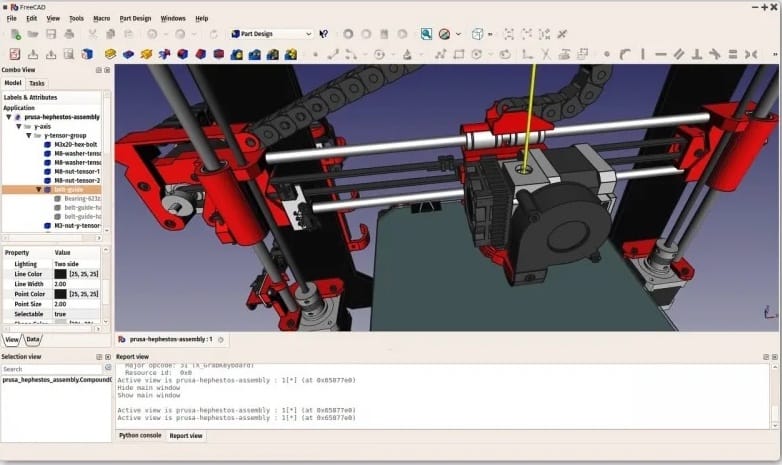How To Install FreeCAD on Manjaro

FreeCAD stands as one of the most powerful open-source parametric 3D modeling applications available today. This comprehensive guide will walk you through multiple installation methods for FreeCAD on Manjaro Linux, ensuring you can choose the approach that best suits your needs and technical requirements.
Whether you’re a mechanical engineer, architect, or hobbyist designer, FreeCAD offers robust parametric modeling capabilities that rival commercial CAD software. Manjaro’s rolling release model and excellent package management make it an ideal platform for running FreeCAD, providing access to both stable releases and cutting-edge development versions.
This tutorial covers four primary installation methods, from official repositories to compilation from source. Each method has distinct advantages, and understanding these differences will help you make an informed decision based on your specific use case and requirements.
Understanding FreeCAD and Its Capabilities
FreeCAD is a parametric 3D modeler designed primarily for creating real-life objects of any size. The software excels in mechanical engineering, architecture, and product design through its feature-based modeling approach. Users can create models with predefined parameters that can be easily modified later, making iterative design changes straightforward and efficient.
The modular architecture allows extensive customization through plugins and modules, while support for multiple file formats including STEP, IGES, STL, OBJ, and DXF ensures compatibility with other CAD systems. FreeCAD also includes comprehensive 2D drafting tools for technical drawings and documentation purposes.
Why Choose Manjaro for FreeCAD?
Manjaro’s Arch-based foundation provides several advantages for FreeCAD users. The rolling release model ensures access to the latest software versions, while the Arch User Repository (AUR) offers experimental builds and specialized versions like freecad-realthunder. The package management system handles dependencies efficiently, reducing installation complexity.
System Requirements and Prerequisites
Hardware Requirements
FreeCAD requires specific hardware specifications for optimal performance. The minimum system requirements include a 64-bit processor, preferably multi-core, with at least 4GB of RAM. However, for professional work and complex models, 8GB or more RAM is recommended.
Graphics capabilities are crucial for 3D modeling. An OpenGL-compatible graphics card is essential, with OpenGL 4.0 support or higher recommended for advanced features. Dedicated graphics cards significantly improve performance compared to integrated solutions, especially when working with large assemblies or performing rendering operations.
Storage requirements are modest, with 1GB of free disk space for basic installation. However, an SSD with at least 10GB of free space is recommended for better performance. Complex projects and additional workbenches may require additional storage space.
Software Prerequisites
Manjaro Linux compatibility extends across recent versions, with the system requiring current libraries and dependencies. Python version compatibility is crucial, as recent updates have shown compatibility issues with Python 3.13 in some macros and extensions. The Qt framework integration ensures proper user interface rendering and functionality.
Method 1: Installation via Official Repositories
Using Pacman Package Manager
The most straightforward installation method uses Manjaro’s built-in package manager. Open a terminal and update your system packages:
sudo pacman -SyuInstall FreeCAD directly from the official repositories:
sudo pacman -S freecadThis command automatically resolves dependencies and installs the stable version available in Manjaro’s repositories. The installation process typically completes within a few minutes, depending on your internet connection speed.
Verify the installation by checking the version:
freecad --versionLaunch FreeCAD from the terminal:
freecadAlternatively, access it through your desktop environment’s application menu by searching for “FreeCAD.”
Advantages and Limitations
The official repository method provides excellent system integration with automatic dependency resolution and seamless updates through the standard system update process. The packages undergo thorough testing for compatibility with your Manjaro version, ensuring stability and reliability.
However, repository versions typically lag behind the latest FreeCAD releases, as Manjaro prioritizes stability over bleeding-edge features. This method is ideal for users who prefer stability and don’t require the absolute latest features or experimental functionality.
Method 2: Installation via AUR (Arch User Repository)
Enabling AUR Support
The AUR provides access to community-maintained packages, including the latest FreeCAD versions and specialized builds. Enable AUR support through Pamac, Manjaro’s graphical package manager.
Open Pamac (Add/Remove Software) from your application menu. Navigate to preferences and enable AUR support in the settings. This requires checking the “Enable AUR support” option and potentially entering your password for authentication.
Installing FreeCAD from AUR
Search for FreeCAD packages in Pamac with AUR enabled. You’ll find several options including:
freecad– Standard AUR packagefreecad-git– Development version from Gitfreecad-realthunder– Experimental Link branch version
For command-line installation, use:
pamac build freecadThis command downloads the source package, compiles it locally, and installs the resulting package. The process may take significant time depending on your system’s performance and the package complexity.
Managing AUR Dependencies
AUR packages sometimes require additional dependencies not available in official repositories. Common issues include Python-related packages like shiboken and pyside. Monitor the build process for dependency warnings and install missing packages as needed.
Recent users have reported python-shiboken2 dependency issues that can prevent FreeCAD from launching. These issues are typically resolved through system updates, but manual dependency management may be necessary in some cases.
Method 3: Installation via Snap Packages
Setting Up Snapd
Snap packages provide containerized applications with bundled dependencies. Install snapd on Manjaro:
sudo pacman -S snapdEnable the snapd systemd service:
sudo systemctl enable --now snapd.socketCreate the necessary symbolic link for snap command availability:
sudo ln -s /var/lib/snapd/snap /snapInstalling FreeCAD via Snap
Install the official FreeCAD snap package:
sudo snap install freecadAlternative snap packages include freecad-realthunder for the experimental Link branch version. The snap installation handles all dependencies automatically and provides automatic updates.
Snap-Specific Considerations
Snap packages run in a sandboxed environment, which may limit file system access permissions. You might need to manually grant access to specific directories for file operations. The containerized nature ensures consistent behavior across different Linux distributions but may impact integration with system themes and desktop environments.
Performance implications exist due to the containerization overhead, though these are generally minimal for most users. Snap packages update automatically in the background, ensuring you always have the latest version available.
Method 4: Alternative Installation Methods
AppImage Installation
AppImage provides portable application packages that run without installation. Download the latest FreeCAD AppImage from the official website or GitHub releases page. Make the downloaded file executable:
chmod +x FreeCAD-*.AppImageRun the application directly:
./FreeCAD-*.AppImageAppImages offer portability and don’t require system-level installation, making them ideal for testing different versions or running FreeCAD on systems where you lack administrative privileges.
Flatpak Installation
Flatpak provides another universal package format with sandboxing capabilities. Install Flatpak support:
sudo pacman -S flatpakAdd the Flathub repository:
flatpak remote-add --if-not-exists flathub https://flathub.org/repo/flathub.flatpakrepoInstall FreeCAD via Flatpak:
flatpak install flathub org.freecadweb.FreeCADLaunch the application:
flatpak run org.freecadweb.FreeCADManual Binary Installation
Direct binary installation involves downloading pre-compiled packages from the FreeCAD website. Extract the archive to your preferred location and create desktop entries manually. This method provides maximum control over the installation location and configuration but requires manual updates and dependency management.
Compilation from Source
When to Compile from Source
Source compilation provides access to the absolute latest development features and allows custom build configurations. This method is recommended for developers contributing to FreeCAD or users requiring specific compilation options not available in pre-built packages.
Build Dependencies and Tools
Installing build dependencies requires several packages:
sudo pacman -S base-devel cmake qt5-base qt5-tools python python-pyside2 opencascade coin shiboken2 python-pivyAdditional dependencies may be required depending on the specific FreeCAD version and desired features. The build process requires significant system resources and time.
Compilation Process
Clone the FreeCAD source repository:
git clone https://github.com/FreeCAD/FreeCAD.git
cd FreeCADCreate a build directory and configure with CMake:
mkdir build
cd build
cmake ..Compile the source code:
make -j$(nproc)Install the compiled version:
sudo make installThe compilation process may take several hours depending on your system’s performance. Monitor for errors and install missing dependencies as needed.
Post-Installation Configuration
Initial Setup and Preferences
Launch FreeCAD and complete the initial configuration. Select your preferred workspace from the available options, including Part Design, Sketcher, and Draft workbenches. Configure units and measurement systems to match your project requirements.
Customize the interface layout, toolbar arrangement, and color schemes through the preferences dialog. Set up default file locations for projects and templates to streamline your workflow.

Essential Add-ons and Workbenches
Install popular community workbenches to extend FreeCAD’s capabilities. The Assembly4 workbench provides advanced assembly modeling features, while the A2plus workbench offers alternative assembly tools. The BIM workbench adds building information modeling capabilities for architectural projects.
Access the Addon Manager through the Tools menu to browse and install additional workbenches, macros, and preference packs. Some popular additions include FCGear for gear generation and Fasteners for standard hardware components.
Troubleshooting Common Issues
Launch and Runtime Problems
If FreeCAD fails to start after installation, check for missing dependencies. Common issues include python-shiboken2 problems that prevent proper launching. Update your system packages to resolve dependency conflicts:
sudo pacman -SyuVerify Qt and Python dependencies are correctly installed and compatible. Some users report issues with PySide2 dependencies that require manual installation or updates.
Version Confusion and Package Conflicts
Multiple installation methods can create conflicts between different FreeCAD versions. Use the following command to check installed packages:
pacman -Qs freecadRemove conflicting installations before installing from a different source. Clean uninstallation procedures vary by installation method but generally involve removing the package and associated configuration files.
Graphics and Display Issues
UI rendering problems often relate to graphics driver compatibility or display server configuration. OpenGL support is crucial for proper 3D viewport functionality. Update graphics drivers and verify OpenGL support:
glxinfo | grep OpenGLWayland compatibility issues may require switching to X11 for optimal performance. Configure your display manager to use X11 sessions if experiencing graphics problems under Wayland.
Performance Optimization
FreeCAD performance can be optimized through several configuration changes. Adjust memory usage settings in preferences for large models. Enable multi-threading where available, though note that OpenCASCADE Technology has limited multi-threading support currently.
Graphics performance tuning includes disabling anti-aliasing for complex models and adjusting selection highlighting settings. Monitor system resource usage during heavy operations and consider hardware upgrades if consistently encountering performance bottlenecks.
Getting Started with FreeCAD
Basic Navigation and Interface
FreeCAD’s interface consists of several key components: the 3D viewport, combo view panel, and workbench selector. The navigation cube in the viewport corner provides quick orientation changes, while mouse navigation follows standard CAD conventions with middle-click for rotation and scroll for zooming.
Workbench selection dramatically changes available tools and workflows. Start with the Part Design workbench for solid modeling or Sketcher for 2D constraint-based drawing. Each workbench provides specialized tools optimized for specific design tasks.
Creating Your First Project
Begin with a simple sketch-based design workflow. Create a new document and switch to the Sketcher workbench. Create a basic 2D sketch with geometric constraints, then switch to Part Design to extrude the sketch into a 3D solid.
Practice fundamental operations like padding, pocketing, and filleting. Understanding parametric relationships between features enables powerful design modification capabilities that distinguish FreeCAD from traditional 3D modeling software.
Best Practices and Tips
Choosing the Right Installation Method
Select installation methods based on your specific requirements. Official repositories provide maximum stability for production environments, while AUR offers access to latest features and experimental builds. Snap packages balance convenience with reasonable performance for most users.
Development environments benefit from source compilation or development versions, while casual users should prefer stable repository versions. Consider your update preferences, as some methods provide automatic updates while others require manual intervention.
Maintenance and Updates
Establish regular update schedules appropriate to your installation method. Repository installations update through standard system updates, while AUR packages require periodic rebuilding. Snap packages update automatically but can be controlled through snap settings.
Monitor FreeCAD community forums and release notes for important updates, especially when using development versions. Back up important project files before major updates to prevent data loss from compatibility issues.
Congratulations! You have successfully installed FreeCAD. Thanks for using this tutorial for installing FreeCAD on your Manjaro Linux system. For additional help or useful information, we recommend you check the official FreeCAD website.